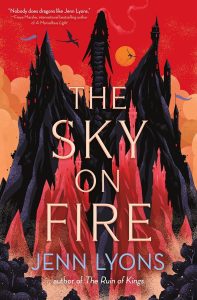Liz Bourke Reviews The Sky on Fire by Jenn Lyons
 The Sky on Fire, Jenn Lyons (Tor 978-1-250-34200-3, $29.99, 448pp, hc) July 2024. Cover by Michael Rogers.
The Sky on Fire, Jenn Lyons (Tor 978-1-250-34200-3, $29.99, 448pp, hc) July 2024. Cover by Michael Rogers.
Jenn Lyons made her debut with The Ruin of Kings, first of a five-book series (“the Chorus of Dragons”) that took epic fantasy, shook it, subverted it, and played entertaining games with the pieces that fell out. The Sky on Fire is not at all related to that series, except that it builds on Lyons’s well-established skill and interest in playing with genre and excavating what makes it work.
For my money, The Sky on Fire is better – tighter, tenser, and more playful – than her previous work: part heist, part caper, and part quiet revolution, set against a vividly epic frame, with a compelling voice and a fascinating cast of characters.
The world is ruled by dragons. They need humans to help them deal with the consequences of their magic: Human “riders” allow dragons to use more magic without going into a kind of destructive madness called rampancy. But the difference in power means that humans are dragons’ subjects, and riders are effectively enslaved by their dragons. This dragon-ruled society occupies high peaks and considers themselves civilised. Plenty of people live down in the Deep – the hot, harsh, dangerous jungle of the lowlands, where the tree canopy means few places for a dragon to land – but to the dragon-ruled upland society, the Skylands, the inhabitants of the Deep are barbarians.
Fifteen years ago, Anahrod Amnead was condemned to death and thrown out of the sky. There’s no reason to think she survived, but at least one dragon apparently does. He’s not wrong. Against all reason, Anahrod did survive, and has made her own way through the Deep ever since. Currently she’s in a spot of trouble, since the emissaries of a local warlord, Sicaryon (Anahrod’s old flame), keep trying to invite her home. This latest time they’ve resorted to violence when she refused. The arrival of a party of strangers – five Skylanders – adds to the violence, though they have to make common cause with Anahrod in order to escape.
Hunted across the Deep, Anahrod learns something of her new companions, a motley, misfit crew. One of them is a teenager, the boy Gwydinion. One of them is a dangerously attractive dragonrider, Ris. Dragons and their riders are particularly dangerous to Anahrod: It was Neveranimas, regent for the dormant dragon king Ivarion, who wanted her dead. Too late, she discovers that these are no ordinary adventurers. They were looking for her specifically.
Anahrod isn’t the only person with the right to a grudge against Neveranimas. Ris has one too. And Ris has a plan for revenge against Neveranimas and her right-hand dragon Tiendremos – in fact, a complicated set of plans within plans, heist and caper intended to lead to Tiendremos’s and Neveranimas’s ruin – which requires Anahrod’s participation. And she’s not taking no for an answer.
Lyons divides The Sky on Fire into ten separate sections, each of which has a different central focus. They function as episodes building towards the climax, and include multiple reversals and surprises of their own. Each episode reveals new information about the world and complicates our understanding of the characters, and each, also, includes at least one startling revelation or fresh problem. Lyons delights in ensuring the reader can never get complacent. In this regard, The Sky on Fire reminds me of the television show Leverage at its peak: nail-bitingly tense, superbly well-paced, with intensely personal stakes – but set in an epic world, with epic dangers and (as we discover) potentially world-changing stakes.
Speaking of epic, The Sky on Fire leans into its epically inventive worldbuilding. This world is ecologically distinctive, and also has clearly distinct zones. A striking interlude takes place when Anahrod, having been kidnapped into the Skylands by Ris and her crew, escapes her captors and signs on to work on a whaling cutter – a vessel that harvests the precious material of sky amber, with its floating properties, from whales of the sky. (This is the context in which Anahrod discovers her past brush with death has left her with a terror of heights that will continue to haunt her. She’s not having it easy.) Lyons gives us a vividly imagined world, one that extends beyond the edges of the page.
The world and its context unfold side-by-side with the caper and revenge plot. In the Skylands, the state religion essentially holds that humans were created to serve dragons. Magically talented humans either become dragonriders or are forced into the church, to serve the draconic ruling class in a different fashion. Different magical talents manifest in different ways: Anahrod, for example, has a gift for hearing the thoughts of animals and controlling them. The Skylands use a kind of magical technology called inscription, which allows objects to be enhanced or altered with magic, and anyone can use those objects. In the Deep, the only available magic is the sorcery of trained talents, because who in the Skylands would educate a barbarian about their technologies?
When Sicaryon re-emerges into the narrative, a more pointed comparison between Deep and Skylands societies comes into view, as does a comparison between Sicaryon – a king who found power not worth the cost, striving to turn his society into one where he can be redundant, nothing more than a figurehead – and the dragon regent Neveranimas, who hoards both power and secrets like a miser. Neveranimas has no desire to cede power to anyone, much less return it to the hundred-years-dormant dragon king Ivarion, a reformer in his time. Neveranimas’s relationship with power, and her inability to see other thinking beings as anything other than tools, drives her to eradicate all potential threats or inconveniences to that power.
Sicaryon’s presence also lets Lyons play with misunderstandings and the reversal of the reader’s expectations. Not for the first, or indeed last time: Anahrod’s family is also another place where Lyons plays with expectations, as is the dragonrider Ris and her unusual dragon partner Peralon, who upends Anahrod’s expectations, at least, for what kind of relationship is possible between dragon and human.
Speaking of relationships, I’m very entertained to find The Sky on Fire the second novel I read in a row to have a very matter-of-fact approach to kink. Its approach to sexuality and gender is also matter-of-factly queer and more trans-inclusive than most (trans men and women are “late-blooming” men or women) and makes no big deal about its polyamory. The relationship between Anahrod and Ris is fast-moving but complicated by circumstances, suspended between attraction and the awareness that making decisions based primarily on attraction would be a bad idea, with an unhealthy dose of secrets, but it makes for a compelling extra layer to the caper-heist with all a caper’s potential for betrayal and double-cross.
The characters of The Sky on Fire come provided with epic-quality backstories, though we only glimpse them sidelong. Anahrod is introduced to the final stages of a plan years in the making, with people who have complex histories in the world and with each other. In other hands, it would be easy for a reader to become lost, but Lyons drives the engine of this tightly constructed narrative – a precisely calibrated work of art – with discipline and verve. Honestly, this novel marries epic and caper with such skill that I want to pick it apart with focused attention just to admire how well it’s put together.
Liz Bourke is a cranky queer person who reads books. She holds a Ph.D in Classics from Trinity College, Dublin. Her first book, Sleeping With Monsters, a collection of reviews and criticism, is out now from Aqueduct Press. Find her at her blog, her Patreon, or Twitter. She supports the work of the Irish Refugee Council and the Abortion Rights Campaign.
This review and more like it in the June 2024 issue of Locus.
 While you are here, please take a moment to support Locus with a one-time or recurring donation. We rely on reader donations to keep the magazine and site going, and would like to keep the site paywall free, but WE NEED YOUR FINANCIAL SUPPORT to continue quality coverage of the science fiction and fantasy field.
While you are here, please take a moment to support Locus with a one-time or recurring donation. We rely on reader donations to keep the magazine and site going, and would like to keep the site paywall free, but WE NEED YOUR FINANCIAL SUPPORT to continue quality coverage of the science fiction and fantasy field.
©Locus Magazine. Copyrighted material may not be republished without permission of LSFF.





